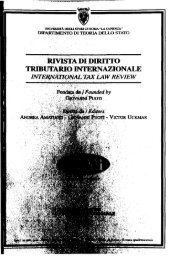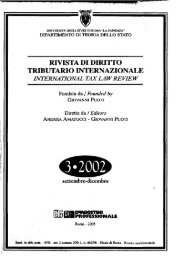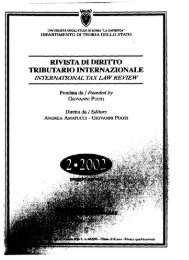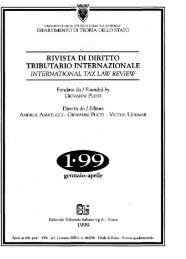RIVISTA DI DIRITTO TRIBUTARIO INTERNAZIONALE - Rdti.it
RIVISTA DI DIRITTO TRIBUTARIO INTERNAZIONALE - Rdti.it
RIVISTA DI DIRITTO TRIBUTARIO INTERNAZIONALE - Rdti.it
You also want an ePaper? Increase the reach of your titles
YUMPU automatically turns print PDFs into web optimized ePapers that Google loves.
A. S. Bergantino: Tonnage tax: the Italia n proposal al1d the European experiences<br />
Employrnent too - both direct and indirect - has been significantly on<br />
the rise: in the Netherlands, where measures to promote employrnent in the<br />
sector were first introduced and where the regime can be adopted only if a<br />
substantial part of the management and control activ<strong>it</strong>ies are carried out in<br />
the country in question, there has been a 205% increase in direct employment<br />
and a 23% increase in indirect employment. In the Un<strong>it</strong>ed Kingdom,<br />
where the c<strong>it</strong>y of London is the world leader for mar<strong>it</strong>ime financial service,<br />
the increase of indirect employrnent has peaked to 25%. In Norway, owing<br />
to well-aimed policies and to a process whereby the working at sea has been<br />
widely promoted through marketing campaigns, there has been a 23% increase<br />
in the number of cadets enrolling at mar<strong>it</strong>ime training schools.<br />
Last but not least, the increase in the orders of new ships in ali the<br />
countries considered w<strong>it</strong>h the exception of the Un<strong>it</strong>ed Kingdom - where,<br />
however, the shipbuilding industry has practically disappeared - has been<br />
particularly significant.<br />
As mentioned earlier, though the reported percentages are to be considered<br />
in the light of the pre-existing s<strong>it</strong>uation and taking into account<br />
that the tonnage tax has, in generai beeen accompanied by the introduction<br />
of other incentive measures, indications are that the new tax regime<br />
has noticeably improved the overall cond<strong>it</strong>ions of the industry.<br />
5. Main features of the Italian proposal and open issues<br />
In Ilaly, the Bililays down the following:<br />
- the tonnage tax should be fixed in accordance w<strong>it</strong>h the Commun<strong>it</strong>y<br />
guidelines on state aid to mar<strong>it</strong>ime transport and w<strong>it</strong>h the terms of implementation<br />
required by similar regimes set up in other member states;<br />
- the tax should be based on a fixed tax system for each net register<br />
ton and that different classes of tonnage should be identified;<br />
- the un<strong>it</strong>ary rate per ton should be decreasing in total tonnage;<br />
- the option should be irrevocable for a minimum period of five years.<br />
A trasfer pricing regime is also provided for w<strong>it</strong>h respect to transfers<br />
of goods and services among companies electing into the lump-sum<br />
regime and companies which do not.<br />
A number of aspects of the outline presented above are w<strong>it</strong>h no doubt<br />
to be appreciated: the reference to Commun<strong>it</strong>y legislation, the provision<br />
regarding the optional nature of the new regime, the antiavoidance measures<br />
and the ring fencing solutions proposed therein.<br />
However, some features of the provision as formulated in the Bill need<br />
carefully scrutiny in a number of respects, and, might possibly require slight<br />
adjustments already during the Parliament scrutiny (Bergantino, 2002).<br />
<strong>RIVISTA</strong> <strong>DI</strong> <strong>DI</strong>RfITO <strong>TRIBUTARIO</strong> <strong>INTERNAZIONALE</strong> 312001






